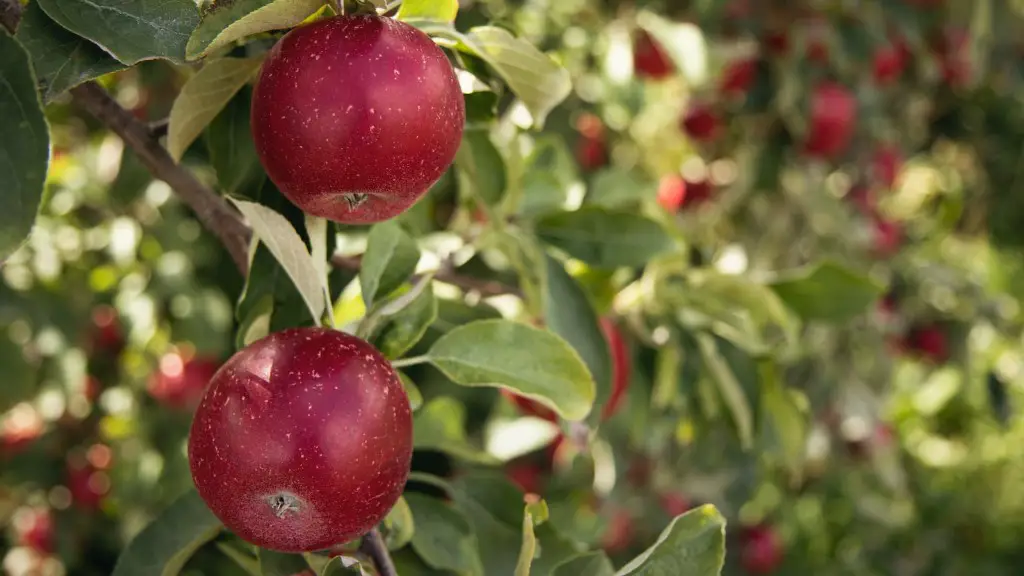Controlling an apple tree’s fruit production is as important for homeowners and orchardists as it is for commercial growers. One of the most effective ways to do this is by pruning. Proper pruning reduces the amount of fruit produced, helps with tree maintenance and can even improve the quality and size of fruit. In addition to pruning, there are several other strategies that can be applied to limit fruit production on apple trees, such as thinning, fertilizing and using pesticides.
Pruning
Pruning is essential in managing an apple tree’s fruit production. Pruning is a process that involves the selective removal of branches and limbs to control the shape, growth and size of the tree. Pruning in apple trees should begin when the tree begins to produce fruit, typically in the second or third year of growth. Pruning in the fall after harvest helps to reduce the amount of fruitful buds for the next year and therefore can reduce the amount of fruit produced. Pruning should also be done in early spring just before the buds swell, to help improve air circulation and light distribution.
Thinning
Thinning is another key strategy to reduce the amount of fruit produced by an apple tree. This process involves removing some of the fruits while they are still attached to the tree. Removing extra fruits can help the remaining fruits to grow to their maximum size. Ideally, fruits should be spaced 5-7 inches apart, with no more than one or two fruits per cluster. Thin very early in the season, within two weeks of full bloom. If thinning is done later in the season the remaining fruits will be too big to gain the full benefit of thinning.
Fertilization
Fertilization can be an effective way to reduce the amount of fruit production on an apple tree. Applying fertilizer too close to bloom time can lead to increased fruit production, while applying fertilizer right after bloom can help to reduce it. Fertilizer should be limited to the base of the tree, adjacent to its trunk and roots, and should not touch the trunk of the tree itself.
Pesticides
Using pesticides can also be helpful in reducing fruit production on an apple tree. Not all pesticides are designed to reduce fruit production, however there are several that can be used. The best time to apply these pesticides is shortly after full bloom and every 6-8 weeks thereafter. Care should be taken when applying these pesticides as too much can damage the tree and can harm beneficial insects.
Using A Mixture of Strategies
Getting the best results when managing fruit production on an apple tree requires a combination of pruning, thinning, fertilization and pesticides. Pruning helps to reduce the number of fruit buds the tree produces and thinning helps to reduce the number of fruits the tree produces, while fertilizing and pesticides help to reduce the amount of nutrients and pests that can decrease fruit production.
TIme of Year is Important
Timing is key when managing fruit production in an apple tree. Pruning should take place after harvest and again in the spring just before buds swell. Fertilizing should be done just after bloom and then again every 6-8 weeks. Thinning should take place within 2 weeks of full bloom and pesticides should be applied shortly after full bloom and every 6-8 weeks thereafter.
Creating Good Growing Conditions
Creating the appropriate growing conditions for an apple tree is an important factor in reducing the amount of fruit produced. Providing good air circulation and light, creating the right soil environment and water levels, and controlling pests and weeds, are all important indicators of fruit production. Understanding the needs and requirements of the tree is key to managing its fruit production and creating a sustainable environment for its growth.
Choose Varieties that Don’t Fruit Too Much
Another way to reduce fruit production on an apple tree is to select a variety that is not overly productive. Apple trees produce differently and some will have more or less fruit than others. Selecting trees that are less prone to fruit production, or have alternate bearing habits, can help to reduce the amount of fruit produced.
Interfering with Pollination
Pollination is important to fruit production in apple trees and can be managed by interfering with the pollination process. Covering the tree with a bag or piece of cloth during bloom will drastically reduce the amount of pollination that can occur and therefore reduce the amount of fruit the tree will produce. This method is disruptive and can produce lower-quality fruit, but is a viable approach to reduce fruit production.


